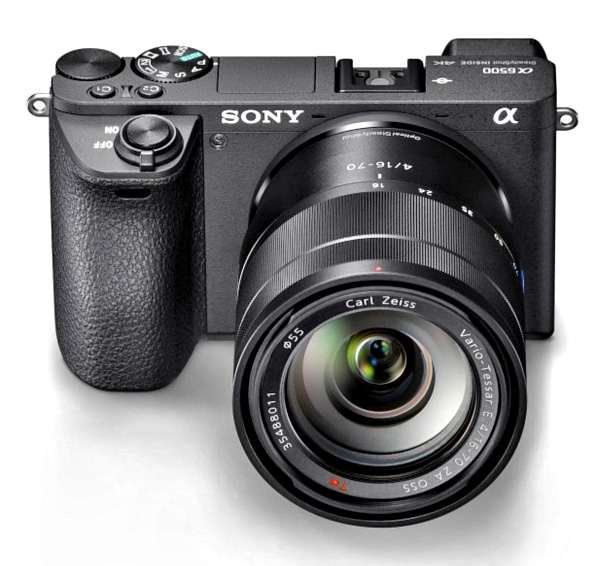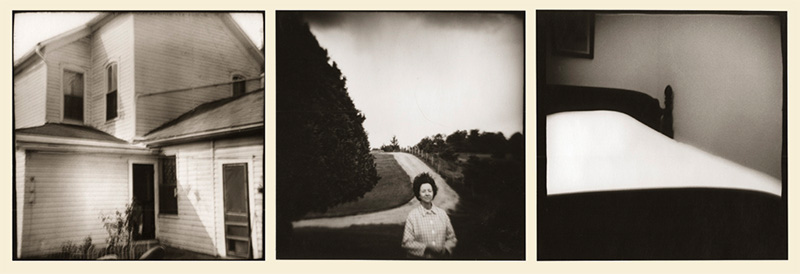• Gordon left this morning, and somehow over the three days he was here we didn't manage to set a start day for the Precipitation II sale. It's going to be three days only (note well!) and will probably start soon. I'll check with him later today and update this post.
[UPDATE: The sale starts Wednesday morning and will continue through Friday evening.]
• I'm going to be reviewing the Sony A6500 this month, with the Zeiss/Sony (Sony/Zeiss?) 16–70mm ƒ/4 lens. It will be on the way from B&H Photo as soon as they reopen after Yom Kippur.
 • I received my copy of Nancy Rexroth's Iowa this week. I'm happy to report that it's a full-swing meat-of-the-bat home-run hit. As a hardcover with 22 more images and more verbal matter than the original, it's a more substantial production than the slender, delicate paperback of 40 years ago, but I don't see any downside to that—the new pictures blend seamlessly with the old, and the spot-varnished reproductions are very pleasing.
• I received my copy of Nancy Rexroth's Iowa this week. I'm happy to report that it's a full-swing meat-of-the-bat home-run hit. As a hardcover with 22 more images and more verbal matter than the original, it's a more substantial production than the slender, delicate paperback of 40 years ago, but I don't see any downside to that—the new pictures blend seamlessly with the old, and the spot-varnished reproductions are very pleasing.
Disclosure: Mark L. Power, who wrote the introduction to the original and adds an update here, was one of my teachers at the Corcoran School of Art, and we're still in touch occasionally. He adds a new coda in the book, "Iowa Since 1975," facing his own portrait of Nancy. "What was remarkable then, and remains remarkable still," Mark writes, "is how a self-published book with such a small print run has had such a long and influential life well after the original went out of print. Almost immediately, the book became an underground classic."
Here's the most telling comment he makes: "Over the years, I would periodically show my battered copy of IOWA to students, and the result was always the same: an immediate influence on student work, and more than that, a change in thought about the medium itself."
I believe that. I experienced it with my own students a few times.
Nancy Rexroth is represented by Robert Mann Gallery
The pictures in Iowa are about as anti-"now" as it's possible to be. They're soft, dreamlike, often enigmatic, and so elliptical they sometimes show very little, up to basically nothing. Like a sort of Zen sketch with just a few lines, they imply their subjects with just a few masses of tone. They're not just loose, they're impressionistic—like glimpses, or an image in a dream that you try to hang on to in your mind but can't.
But overall I find looking at the book a moving experience even now, and oddly freeing—as a whole it seems to promise that we really can ignore every rule and photograph our own memories and feelings if we want to. The pictures are almost like Rorschach patches that bring out the sweet wistfulness of long-bygone days in our own past.
That said, Iowa won't be for everyone. They're toy camera pictures. You need to be open to it. But I'm guessing that letting it in and letting it influence you could be liberating if you've been finding your own work stiffened up or inhibited lately. (If you liked Saul Leiter you'll probably like Iowa.)
The book is a central accomplishment of romantic impressionism in American photography, and now it has its ideal edition (big kudos to the people at University of Texas Press, by the way). I've never owned it before. I know right where I'm going to file mine: on the shelf just to the right of Walker Evans's American Photographs and Robert Frank's The Americans.
Anyway I said I'd update you about the quality of the bookmaking, and it's impeccable. Here it is on Amazon U.S., Amazon U.K., and from The Book Depository, which offers free shipping worldwide.
Mike
(Thanks to Mark L. Power and Jim Sherwood)
Original contents copyright 2017 by Michael C. Johnston and/or the bylined author. All Rights Reserved. Links in this post may be to our affiliates; sales through affiliate links may benefit this site.
(To see all the comments, click on the "Comments" link below.)
Featured Comments from:
Blake: The production quality of the new Iowa is indeed very high, but I wouldn't call it impeccable as you do. Many of the original images have been improved with new scans showing better tonal gradation. But some images have been over-sharpened, while others have worse tonality than the originals. The last chapter, with subtle colors added to the monochromes, is too garish. Almost all the images have had the original Diana carrier marks cropped to thin borders, a change that for me makes them feel more perfected, with less of their original analogue spirit of whimsy. Not to gripe too much. The new edition is a very welcome addition to my library. But impeccable? Probably no photobook fits that description.
Mike replies: I'll defer to you on the details, Blake (it's been since Reagan was President that I've seen a first edition copy, and I didn't compare the two), but how do you know that the changes aren't simply Nancy herself changing her mind about how she wants the pictures to look? She was involved with the production of the new edition, after all. What I meant by "impeccable" is that I see nothing at all to detract from anyone's experience of the book, or their satisfaction with this anniversary reissue. After all, apart from being different from the original in some ways, it's better than the original in many ways, too.
In a general sense, I've had a lot of experience with "reissues" of various sorts, and I have to admit I generally prefer them. It's a lot of responsibility to own an original of something, is my feeling. It's one thing to buy something new and use it from new, but to buy a "vintage" first edition comes with the responsibility to preserve it in the condition in which one acquires it. One becomes posterity's agent, in a sense. I have my first edition of The Decisive Moment on the shelf right next to the Steidl reprint, and I no longer take the first edition off the shelf and look at it; I don't allow anyone else to, either. I use the reprint if I want to look at the book. Regardless of what they are—books, cameras, records, cars—I'm more comfortable making use of things if they're contemporary and replaceable, rather than precious historical artifacts.
It's not that I'm blind to the charms of vintage originals. I have several original jazz records, and they do sound subtly different than the reissues, and in some ways, although the sound is worse, the experience is better. On the other hand, sometimes I imagine that the reissues are more like the artist originally wanted them to be, but couldn't afford when they created the original.
So I guess readers of this review should take all this into account.
Bill Bresler: "I've used an A6000 with the 16–70mm ƒ/4 for news work for the past couple of years, for stills and video. Heavy use indeed, and it never fails me.
"The only fault of the A6000 is the lack of a jack for an external microphone. The Sony mic connects to the enhanced hot shoe. That microphone's performance over the camera built-in mic is marginal, at best. I've considered the A6300 for that reason alone.
"The A6500 is more than I need, although image stabilization with my old Nikon 180mm ƒ/2.8 + adapter would be nice. Early production runs of the 16–70mm apparently had quality issues, with some evidence of de-centered elements. Mine, however, seems fine. The camera and lens offer, for me, a combination of light weight, great high ISO performance, and very good image quality.
"I still use Nikon DSLRs for shooting sports, but it takes a day to recover after lugging two bodies with a 300mm ƒ/2.8 and the 70–200 ƒ/2.8. Looking forward to your review."
Jamie Pillers: "The new IOWA is beautifully made and the images are gorgeous...and inspirational. With all the overdone sharpness and color we are inundated with these days, images like Nancy's are a welcome relief for the eyes. I love the book."





A Woman's Bed, Logan, Ohio, 1970. [On the right in the three pictures above —Ed.]
That picture alone will challenge most anyone's conception of what the medium of photography can be about...
Posted by: Stan B. | Friday, 29 September 2017 at 12:52 PM
I look forward to Mike's A6000 review. I've owned an NEX-5, NEX-7, A6000 and A6300 -- the last three paired only with the Sony/Zeiss lens. For me they are "walking around" and "always in the car" point and shoot cameras and have delivered many very nice images.
Posted by: Speed | Friday, 29 September 2017 at 01:38 PM
I'll be fascinated to read what you think of that zoom....
Posted by: Dave Wilson | Friday, 29 September 2017 at 02:35 PM
I'm not a big low-res fan, but I have to admit that the IOWA pictures are powerful.
---
Fuzziness, like anything, can be taken too far. Once, a friend showed me a postcard with an art photo which was just blurriness showing nothing except a bit of color change in a corner. He said to me: "Isn't this just a bit too much too little?" And that was just what it was.
Posted by: Eolake | Friday, 29 September 2017 at 02:51 PM
OK Mike, ya pounded me flat. I ordered a copy of Iowa, despite declaring an embargo on new books (which has not gone well so far). I know nothing about it. Never heard of it. Don't care what camera was used to make the pictures. Ya got me with "If you liked Saul Leiter you'll probably like Iowa." I do.
Posted by: Ken Tanaka | Friday, 29 September 2017 at 04:50 PM
For me, ironic and amusing, since I try to create images like that all the time with a DSLR. Interesting work. Her subjects must be perplexed when they ask to see the images she took.
JR
Posted by: John R | Friday, 29 September 2017 at 09:14 PM
Thanks Mike for the mention..very nice review! I'll forward it on to Nancy in case she hasn't read it.
Posted by: Mark Power | Saturday, 30 September 2017 at 01:02 AM
BTW, I’ll soon be headed off to the middle of the Pacific Ocean for several weeks, probably with the A6500 and that Sony-Zeiss 16-70 as my primary rig. It should be an excellent combo in terms of size and performance. I’ve been using it occasionally for a while.
Posted by: Ken Tanaka | Saturday, 30 September 2017 at 08:32 AM
I've had "Iowa" in my Amazon wish list since it was published earlier this month. Your review pushed me to finally order it. The book came on my radar several years back. At the time I was playing with pinhole and Holga toy cameras but I never really accomplished much of value with them. Still, I have admired Rexroth's work ever since. Looking forward to getting the reissue.
Posted by: Dogman | Saturday, 30 September 2017 at 08:41 AM
"...the Zeiss/Sony (Sony/Zeiss?) 16–70mm ƒ/4 lens." I have seen the term "Zony" used to describe this lens.
Posted by: Bruce McL | Saturday, 30 September 2017 at 09:57 AM
This 16-70mm might be a great solution for use as a wide-range walk around lens with an A7R2 in crop mode. There isn't such an offering for the camera in full-frame mode, and there are many times that 42 megapixels is simply overkill. I eagerly await your review!
Posted by: Tom Hassler | Saturday, 30 September 2017 at 10:45 AM
Now where did I put my Diana?
Posted by: Jerry Walsh | Saturday, 30 September 2017 at 11:19 AM
My copy (of Iowa) should be here any day. You are an impeccable recommender of photo-books, so I ordered it when you mentioned it earlier.
(Someday, you might consider a 'Mike's hundred best' so we can see what we are still missing!)
Posted by: Peter Wright | Saturday, 30 September 2017 at 11:32 AM
Bruce McL said: "Zony" ... My question: Is that tony? Or just too cute by half? I like word games, but would never want to appear gauche 8-)
I was one of the first to buy a Sony NEX 5n. I had to buy it with the unwanted (and never used) Kit Zoom, because the body only was not available yet. I replaced the large kit lens with a small 16mm prime. I loved it! It was even better than sliced bread. While shooting video, you could pull focus with the touch-screen—W0W!!.
I've not been tempted by another Sony crop camera—no wide primes available except the 16mm I own, and the huge Zeiss Touit 12mm.
BTW for all you TOP epicures, a chunck of bread torn from a baguette and smeared with chunky peanut butter makes a great snack—no sliced bread needed.
Posted by: cdembrey | Saturday, 30 September 2017 at 05:32 PM
I believe that the "added" tones in the pictures in the last chapter represent her using different processes, such as platinum/palladium and getting prints with those tones and wanting them in the reissue. Also, it seems as though Nancy had full input. Maybe newer printing methods allowed her to make them as she had wanted to. I thumbed my original copy to death so this is a wonderful treat.
Posted by: James Weekes | Saturday, 30 September 2017 at 05:33 PM
Hurrah! I found my copy of the original. The reissue is cleaner and the prints a wee bit bigger but very faithful. Fun to compare.
Posted by: James Weekes | Sunday, 01 October 2017 at 10:14 AM